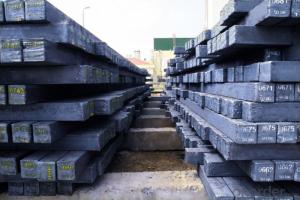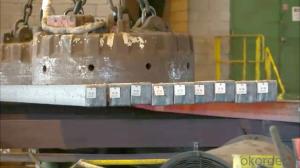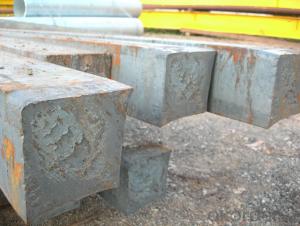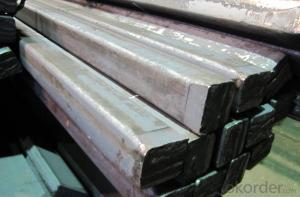Q235/3SP 145MM Blast Furnace Hot Rolled Steel Billet
- Loading Port:
- Tianjin
- Payment Terms:
- TT OR LC
- Min Order Qty:
- 2000 m.t.
- Supply Capability:
- 30000 m.t./month
OKorder Service Pledge
OKorder Financial Service
You Might Also Like
Description of Q235/3SP 145MM Blast Furnace Hot Rolled Steel Billet
Our hot dip galvanised steels consist of a steel substrate with a metallic zinc coating applied by means of a continuous hot dip galvanising process. Metallic zinc coatings are available in steel grades ranging from steel for bending and deep drawing applications, to structural steels and high yield strength steels.
A glossy surface finish obtained under specific skin-pass conditions (either non-skin-passed or skin- passed with smooth cylinders to obtain low roughness) can be provided if required at time of enquiry.
Advantage of Q235/3SP 145MM Blast Furnace Hot Rolled Steel Billet
Uncoated CR steel sheet With the features of in line with the international highest standards in demension and shape, excellent surface finish and properties, the products are mainly used in home appliance and automobile industries.
Galvanized steel sheet(include HDG and EG)
With the features of good corrosion resistance, the products are mainly used in automobile, home appliance, electronics, building and machinery manufacture industries, etc.
Precoated steel sheet With the features of enviromental protection and good processablility, long lasting surface durability, rich in colors, the products are maily used in building, home appliance and furniture industries, etc.
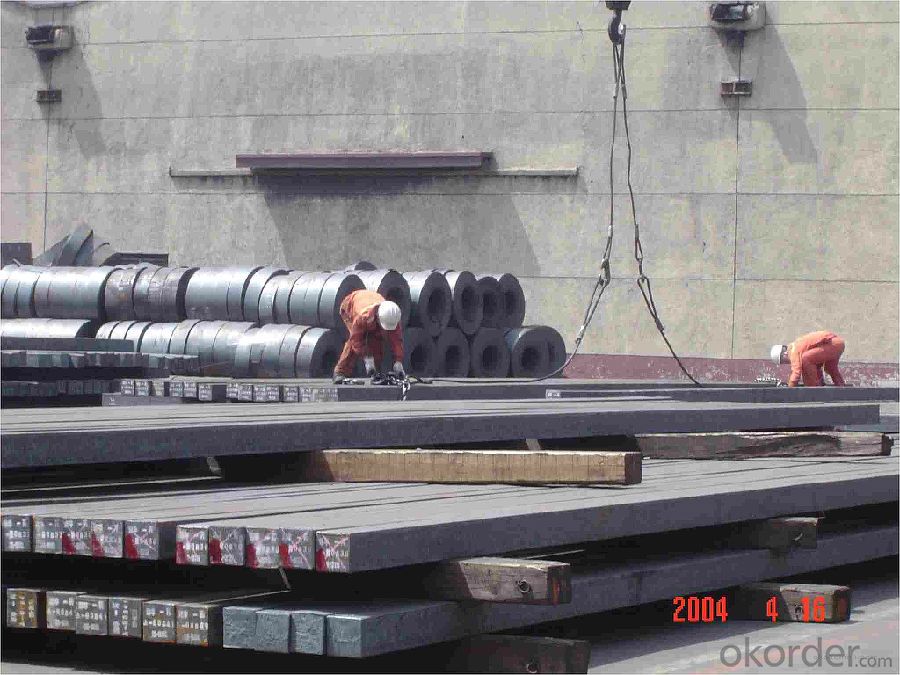
Applications of Q235/3SP 145MM Blast Furnace Hot Rolled Steel Billet
Our hot dip galvanised steels can be used in a very wide range of applications for industrial markets, both indoors and outdoors. Some of the most common applications are:
Building: wide sections for roofing and cladding, doors, door frames, metallic ceilings, partitions, structural members etc
Domestic appliances: all appliances for this sector (both white and brown goods) are manufactured with hot dip galvanised steels
Miscellaneous: electrical cabinets, aeraulic components, air conditioners, road signs etc
Zinc hot dip galvanised steel is suitable for contact with foodstuffs under certain conditions, as specified in European directive 89/109/EEC and French standard NF A 36-712-1. Please contact us for further information on this subject.
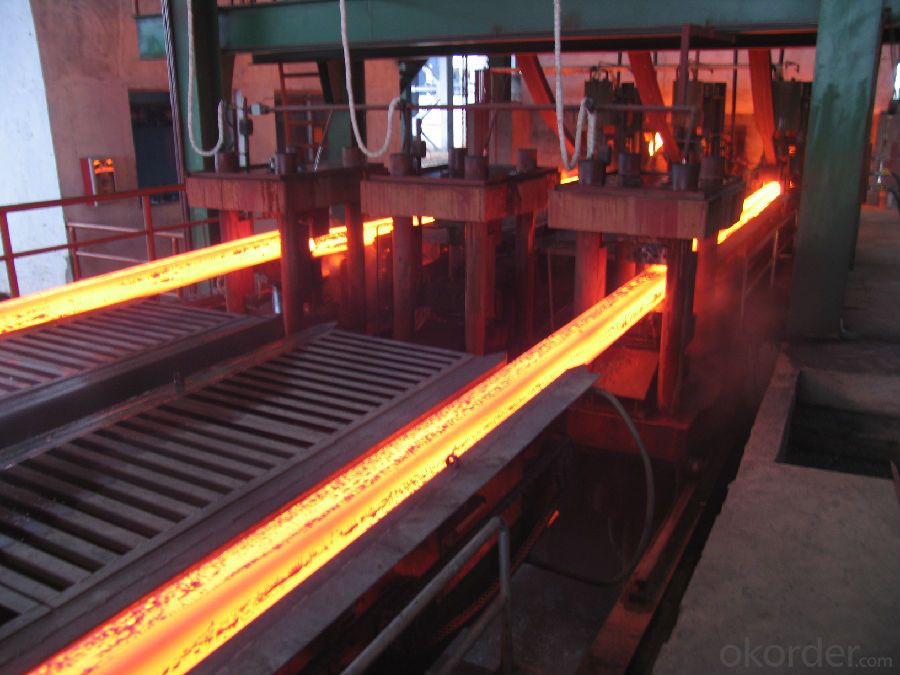
Specifications of Q235/3SP 145MM Blast Furnace Hot Rolled Steel Billet
Quality | Q/BQB 440-2003 | JIS G3312-1994 JIS G3321 | EN 10326-2004 | ASTM A653-02a |
EN 10327-2004 | (BASE PLATE) | |||
(BASE PLATE) | ||||
Commercial Steel | DC51D | SGCC SGLCC | DX51D+Z DX51D+AZ | CS Type A/B/C |
Forming Steel | St01,St02,St03 | SGCD1 SGLCD1 | FS Type A, Type B | |
Drawing | DC52D /DC53D | - | DX52D+Z DX52D+AZ | DDS TYPE A/C |
Steel | DX53D+Z DX53D+AZ | |||
Structural | S280GD (StE28) | SGC400 SGLC400 | S280D+Z DX54D+AZ | SS275 |
Steel | S350GD (StE34) | SGC440 SGLC440 | S350D+Z S350D+AZ | SS340 Class1 |
FAQ of Q235/3SP 145MM Blast Furnace Hot Rolled Steel Billet
We have organized several common questions for our clients,may help you sincerely:
1. How Can I Visit There?
Our company is located in Tianjin City, China, near Beijing. You can fly to Tianjin Airport Directly. All our clients, from home or aboard, are warmly welcome to visit us!
2. How Can I Get Some Sample?
We are honored to offer you sample.
3. Why choose CNBM?
Our delivery time about 15-20days for standard sizes, if you have other requirements like hardness, quanity and width ,it is about 20-40days. But don't worry we also try our best for the delivery time ,because time longer and our cost is higher.
- Q:How are steel billets used in the production of aerospace structures?
- Steel billets are used in the production of aerospace structures as they are melted and cast into various shapes to create critical components such as beams, brackets, and fittings. These billets serve as the raw material that undergoes further processing, including machining, welding, and heat treatment, to meet the specific requirements and tolerances of aerospace applications. The high strength and durability of steel make it an ideal material for aerospace structures, ensuring the safety and reliability of aircraft.
- Q:What is billet?
- Mould blank and continuous casting billet: mould blank and continuous casting billet,
- Q:What are the main factors that affect the availability of steel billets?
- There are several main factors that affect the availability of steel billets. Firstly, the availability of raw materials plays a crucial role. Steel billets are produced by melting iron ore, along with other materials such as coal and limestone, in a blast furnace. The availability and cost of these raw materials can greatly impact the production of steel billets. Any disruptions in the supply chain, such as a shortage of iron ore or a spike in prices, can lead to a decrease in the availability of steel billets. Secondly, the demand for steel billets also influences their availability. The construction and manufacturing industries are the primary consumers of steel billets, using them to produce various steel products such as bars, rods, and beams. If there is a surge in demand for steel products, it can strain the availability of steel billets, especially if the production capacity is not able to keep up with the increased demand. Furthermore, market dynamics and economic conditions can impact the availability of steel billets. Factors such as fluctuations in steel prices, changes in government policies, and trade barriers can affect the overall supply and demand balance. For example, the implementation of tariffs or restrictions on steel imports can reduce the availability of steel billets in a particular region, as domestic production may not be able to meet the demand. Additionally, technological advancements and production capabilities also play a role in determining the availability of steel billets. Improvements in manufacturing processes, such as the use of electric arc furnaces or continuous casting, can increase production efficiency and output. On the other hand, any technical issues or maintenance problems in steel plants can lead to disruptions in production and subsequently reduce the availability of steel billets. In conclusion, the availability of steel billets is influenced by factors such as the availability and cost of raw materials, the demand for steel products, market dynamics, economic conditions, and technological advancements. These factors can individually or collectively impact the availability of steel billets, and it is important for stakeholders in the steel industry to monitor and address these factors to ensure a stable supply of steel billets.
- Q:How do steel billets contribute to the chemical industry?
- Steel billets are an essential raw material in the chemical industry for the production of various chemicals and chemical products. These billets, which are solid bars or rods of steel, play a crucial role in the manufacturing process. Firstly, steel billets are used in the construction of reactors and vessels that are used in chemical production plants. These reactors are designed to withstand high temperatures and pressure, and steel billets provide the necessary strength and durability for these applications. The chemical reactions that take place in these reactors often involve corrosive or harsh chemicals, and the use of steel billets ensures that the equipment remains intact and prevents any leaks or accidents. Furthermore, steel billets are also used in the production of catalysts, which are substances that facilitate chemical reactions without being consumed in the process. Many catalysts are made from metals or metal oxides, and steel billets are often used as the base material for their production. By providing a stable and strong foundation, steel billets help ensure the efficiency and effectiveness of these catalysts. Additionally, steel billets are used in the construction of pipelines and storage tanks that are crucial for transporting and storing chemicals. These structures need to be able to withstand high pressures and corrosive environments, and steel billets are the preferred material due to their strength, durability, and resistance to chemical degradation. They ensure the safe and efficient transportation and storage of chemicals, which is crucial for the chemical industry. In conclusion, steel billets are indispensable in the chemical industry due to their strength, durability, and resistance to chemical degradation. They are used in the construction of reactors, vessels, catalysts, pipelines, and storage tanks, all of which are essential components of chemical production and transportation. Without steel billets, the chemical industry would struggle to operate efficiently and safely.
- Q:How do steel billets contribute to the overall strength of a structure?
- The overall strength of a structure is greatly influenced by steel billets, which serve as essential building blocks. These billets, in their semi-finished form, are utilized as raw materials for producing various structural components. The exceptional strength and durability of steel itself are the primary reasons why steel billets enhance the strength of a structure. This makes steel an ideal construction material. When steel billets are incorporated in the manufacturing process, they lay a solid foundation for creating stronger structural elements. Steel billets are typically shaped into different structural components, like beams, columns, and plates, through hot-rolling or forging. This manufacturing process subjects the steel to high temperatures and pressure, leading to a refined grain structure. The refined grain structure significantly improves the strength and toughness of the steel, making it more resistant to deformation and structural failure. Moreover, steel billets can be further processed to achieve specific mechanical properties required for different structural applications. For instance, heat treatment processes like quenching and tempering can enhance their hardness and toughness. Consequently, the steel can endure higher loads and stresses, thereby contributing to the overall strength and stability of the structure. Apart from their inherent strength, steel billets offer advantages in terms of versatility and design flexibility. They can be easily shaped into various sizes and dimensions, enabling engineers to create intricate structural configurations. This versatility allows for the optimization of the structural design, ensuring maximum load-bearing capacity and overall strength of the structure. Furthermore, steel billets possess excellent weldability, allowing them to seamlessly join with other steel components. This ensures the integrity and continuity of the structure, preventing weak points or potential failure zones. By creating a unified and interconnected system, the steel billets contribute to the overall strength and stability of the structure. In conclusion, steel billets significantly contribute to the overall strength of a structure through their inherent strength, refined grain structure, and ability to undergo various heat treatment processes. They provide a strong foundation for manufacturing structural components, enabling them to withstand high loads and stresses. The versatility and design flexibility of steel billets further optimize the structural design, while their excellent weldability ensures the integrity of the structure. As a result, steel billets are essential in constructing resilient and long-lasting structures.
- Q:How are steel billets recycled or reused?
- Steel billets can be recycled or reused in several ways. One common method is through the process of melting and casting, where the billets are melted down and formed into new steel products. They can also be used as raw material in the production of other steel products, such as bars, rods, or pipes. Additionally, steel billets can be further processed and shaped into various components for construction, automotive, or manufacturing industries. This recycling and reusing of steel billets helps to conserve resources, reduce waste, and lower the environmental impact of steel production.
- Q:How are steel billets inspected for surface defects?
- Steel billets are inspected for surface defects using various methods and techniques to ensure the quality and integrity of the material. One common method is visual inspection, where trained inspectors carefully examine the surface of the billets for any visible defects such as cracks, scratches, pits, or uneven surfaces. They use proper lighting and magnification tools to thoroughly inspect the entire surface area. Another method used is dye penetrant testing. In this technique, a liquid dye is applied to the surface of the billets, which is then allowed to seep into any cracks or defects. After a specified time, excess dye is removed, and a developer is applied. The developer draws out the dye from any defects, making them clearly visible and easy to identify. Magnetic particle inspection is another widely used method. In this process, the billets are magnetized, and iron particles are applied to the surface. Any surface defects disrupt the magnetic field, causing the iron particles to gather around the defect, making them clearly visible upon inspection. This technique is particularly effective for detecting defects such as surface cracks. Ultrasonic testing is also commonly employed for inspecting steel billets. High-frequency sound waves are transmitted through the material, and any surface defects or internal flaws cause reflections or echoes. These reflections are detected and analyzed, providing information about the size, location, and type of defect present. Additionally, eddy current testing can be used to inspect steel billets for surface defects. This method involves passing an alternating current through a probe that is placed near the surface of the billet. Any defects or variations in the material's conductivity cause changes in the eddy currents, which can be detected and analyzed to identify surface defects. Overall, steel billets undergo meticulous inspection using a combination of visual, dye penetrant, magnetic particle, ultrasonic, and eddy current testing methods to ensure that any surface defects are identified and addressed, guaranteeing the quality and reliability of the final product.
- Q:Is there an export duty? Or is there a tax refund?
- Your specification 13*13*6 or 12 meters, this is a square cross section, so 7207120000 this can not be used, your billet carbon content is 0.17 to 0.23% less than 0.25%, so we must use the following7207190000 Other Billets with carbon content less than 0.25%Export tax refund: 0%MFN country of import tariff: 2%General customs duties: 11%Export tariff rate: 0%VAT: 17%
- Q:How are steel billets used in the manufacturing of automotive components?
- The manufacturing of automotive components heavily relies on steel billets, which serve as essential raw materials. These billets, being semi-finished products, undergo shaping into various forms to create the necessary components. To start with, steel billets are heated to a specific temperature, rendering them malleable and easier to manipulate. Once they reach the desired temperature, they are then placed into molds or dies and subjected to intense pressure to achieve the desired form. This entire process is commonly referred to as forging. When it comes to automotive components like engine parts, gears, axles, and suspension components, high strength and durability are crucial requirements. Steel billets are preferred for these applications due to their outstanding mechanical properties, including high tensile strength, toughness, and wear resistance. Following the forging process, the shaped billets undergo further processing utilizing various techniques such as machining, heat treatment, and surface finishing. These procedures are crucial in ensuring that the components meet the necessary performance standards, dimensional accuracy, and surface quality demanded by automotive manufacturers. The utilization of steel billets in the manufacturing of automotive components offers numerous advantages. Steel is easily accessible, cost-effective, and boasts a high recycling rate, making it an environmentally friendly choice. Additionally, steel's versatility allows for a wide range of component designs and customization options, catering to specific automotive requirements. To conclude, the significance of steel billets in the manufacturing of automotive components cannot be overstated. Their malleability and exceptional mechanical properties make them an ideal raw material for forging processes, enabling the production of high-strength and durable components used across various automotive applications.
- Q:How are steel billets shaped into rods or wires?
- Rods or wires are produced from steel billets by undergoing a process called hot rolling. This process involves passing the steel billets through a series of rollers at high temperatures. The initial step is to heat the billets to a temperature above their recrystallization point, which is typically around 1200-1300 degrees Celsius. This temperature is important as it ensures the steel becomes soft and easily malleable, thus facilitating the shaping process. Once the billets have been heated, they are then fed through a series of rollers that gradually decrease their thickness and give them the desired rod or wire shape. The rollers exert pressure on the billets, causing them to elongate and reduce in thickness. The number and arrangement of the rollers may vary depending on the specific requirements of the rod or wire being manufactured. Throughout the hot rolling process, the steel undergoes plastic deformation due to the combination of applied pressure and high temperatures. This plastic deformation enables the steel to change its shape without breaking or cracking. The continuous rolling and reduction in thickness gradually transform the billets into rods or wires. After achieving the desired size and shape, the steel is cooled, typically using air cooling. This cooling process enables the steel to maintain its new shape and hardness. The cooled rods or wires can then undergo further processing, such as additional heat treatments or surface treatments, to enhance their properties and meet specific requirements. In conclusion, the hot rolling process is indispensable in shaping steel billets into rods or wires. It allows for precise control over dimensions and properties, while ensuring the final product meets the desired specifications.
1. Manufacturer Overview |
|
|---|---|
| Location | |
| Year Established | |
| Annual Output Value | |
| Main Markets | |
| Company Certifications | |
2. Manufacturer Certificates |
|
|---|---|
| a) Certification Name | |
| Range | |
| Reference | |
| Validity Period | |
3. Manufacturer Capability |
|
|---|---|
| a)Trade Capacity | |
| Nearest Port | |
| Export Percentage | |
| No.of Employees in Trade Department | |
| Language Spoken: | |
| b)Factory Information | |
| Factory Size: | |
| No. of Production Lines | |
| Contract Manufacturing | |
| Product Price Range | |
Send your message to us
Q235/3SP 145MM Blast Furnace Hot Rolled Steel Billet
- Loading Port:
- Tianjin
- Payment Terms:
- TT OR LC
- Min Order Qty:
- 2000 m.t.
- Supply Capability:
- 30000 m.t./month
OKorder Service Pledge
OKorder Financial Service
Similar products
New products
Hot products
Related keywords

